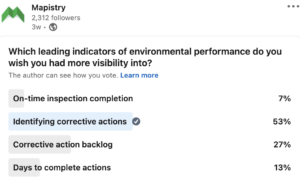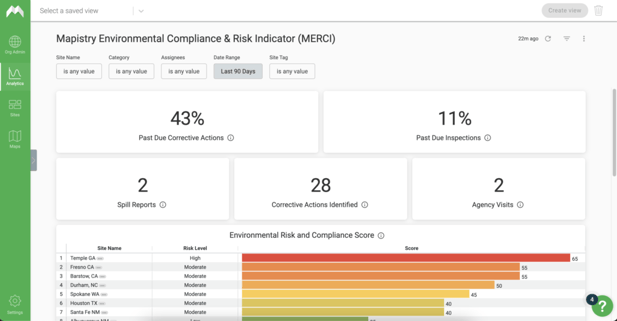Environmental Risk Scorecards for Industrial Facilities
See Your Real-time Environmental Compliance Risk Across Your Facilities
Do you wish you had an easy way to turn your inspection and corrective actions into a real-time risk-based metric, letting you identify top performers and those locations that may need extra support?
Do you feel stuck waiting for results from annual compliance audits or lagging indicators, such as lab results or end of the month emissions reports? With tools like cloud-based mobile inspections and corrective action tracking, you can move from a focus on lagging indicators to a focus on leading indicators.
Announcing Mapistry’s Environmental Risk & Compliance Indicator (MERCI) Scores!
MERCI scores are a combination of real-time leading indicators from each of your sites’ environmental programs and Mapistry’s proprietary dataset on enforcement activities based on geography, likelihood of enforcement action, and size of financial penalty.
Our algorithm calculates an individual facility score so you can see potential liabilities and make more informed decisions about their operations. This enables both environmental and operations leadership to proactively address compliance gaps with limited resources by focusing on the potentially most costly issues.
Why Leading Indicators?
Tracking leading indicators in an environmental compliance program provides valuable information to help you proactively manage your environmental performance. Some of the benefits of tracking leading indicators include the following:

- Early detection of problems: Leading indicators can help you detect potential issues early, allowing you to take corrective action before aviolation occurs, which can prevent fines, legal action, and damage to your reputation.
- Continuous improvement: By tracking leading indicators, you can continuously monitor and improve its environmental performance, ensuring that it remains compliant with regulations and meets its sustainability goals.
- Reduce noncompliance costs: Tracking leading indicators can save money by stopping an issue before it becomes a big mess to clean up or, worse, a violation.
We asked environment leaders what leading indicators they wanted more visibility into, and identification of corrective action was number one!
You should be tracking these leading indicators of top environmental compliance.
- Identification of Corrective Action: When site personnel conduct their routine inspections, they must identify items that are out of compliance; this can include improper labeling of drums, spills, and BMPs that require maintenance. A properly trained inspector will generally find a few issues that must be addressed during each inspection. A long history of no corrective actions is usually indicative of an inspector who is inadequately trained or one who is merely pencil-whipping their inspections.
- Corrective action backlog: Overdue corrective action may result from a lack of funding or staff available to address items and make corrections. This can be a result of budget constraints or poor allocation of resources. Facilities may not have enough employees to address the items identified during an environmental inspection promptly, leading to a backlog of overdue corrective action.
- On-time inspection completion: Overdue inspections are familiar with staff turnover, when individuals responsible for completing the inspection leave their knowledge about what is required for compliance often goes with them, such as missed maintenance and preventative actions. When inspections are not completed at their permitted frequencies, facilities miss the opportunity to spot and correct items before pollutants are released into the environment.

Replace the Annual Audit
Performing an annual compliance audit is standard practice; these audits provide valuable insight into compliance with various laws, regulations, and internal policies. The main objective of this audit is to identify any areas where facilities may be falling short, evaluate the current compliance measures in place, and make recommendations for improvement.
Unfortunately, annual compliance audits are reactive, whereas regular desktop auditing can help identify these issues as they arise, allowing for prompt action to be taken.
Staff turnover, low staffing levels, and budget constraints can be highlighted and addressed faster through real-time desktop auditing. Scoring or scorecards are often used to compare the performance of each facility. MERCI combines leading indicators into a single metric; it is easier to identify top performers and those who may need extra support.
The Benefit of Real-Time Risk Tracking
Technology-enabled solutions that deliver automated risk scoring based on real-time data can help organizations detect and address problems faster, providing a better understanding of real-time risk than outdated annual audits.
Interested in seeing how all mandatory inspections can be leveraged to improve compliance and reduce risk? Get in touch.


%201%20(2).png)

